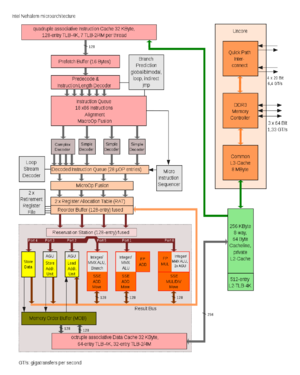Check out my first novel, midnight's simulacra!
Nehalem
From dankwiki


The successor of Core 2, and predecessor of Sandy Bridge.
- Move to 133MHz QPI (Quick Path Interconnect), against which the CPU clock is multiplied
- Reintroduction of SMT (HyperThreading)
- Store-forwarding aliasing issue on 4k strides.
- Double-pumped FP SSE + integer SSE/x87 + load + store units
- Fetch up to 16 bytes of aligned instructions from cache per cycle.
- Up to 4 instructions, no more than 1 complex (this does not necessarily mean 1 µop), decoded per cycle. 64-bit macro-fusion
- Instructions with more than 4 µops are fed from MSROM, and will take more than one cycle in the Instruction Decoder Queue.
- Forwarding results between integer, integer SIMD, and FP units adds latency compared to forwards within the domain.
- One register may be written per cycle.
- 48 load buffers (up from 32), 32 store buffers (up from 20), 10 fill buffers.
- 36 reservation stations (up from 32), 128 ROB entries (up from 96).
- Calltrace cache of 16 entries.
- 2-way loop end BTB for every 16 bytes, 4-way general BTB.
- Loop Stream Detector replays from IDQ if the loop consists of:
- 4 16-byte icache fetches or less
- 28 total µops or less
- 4 taken branches or less, none of them a RET
- preferably more than 64 iterations?
- Be sure to use register parameter-passing conventions, not the stack, to avoid stalls on store-forward of high-latency floating point stores.
- Peak issue rate of 1 128-bit load and 1 128-bit store per cycle.
- Turbo Boost in 133MHz increments
See Also
- The Dark Knight's AnandTech article, 2008-11-03.